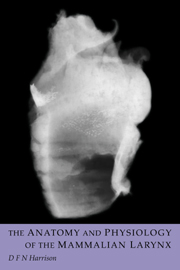5 - Laryngeal physiology
Published online by Cambridge University Press: 05 October 2010
Summary
Respiration
Whilst the study of structure is best discussed under the general heading of morphology, the function of the living organism is considered under the heading of physiology. This is about food, digestion, circulation, respiration and all functions which maintain an animal's fitness for survival. To understand how this is effected it is necessary to be familiar not only with the structure of individual species but also the means by which they adjust to environmental pressures. A comparative approach, examining how mammals solve the hazards of living within the constraints of variable environments, provides some insight into our understanding of the correlation and integration of function necessary for existence. No mammal is independent of its environment and all must be able to cope with its variabilities and challenges.
Comparative mammalian physiology is important as an intellectual discipline in its own right, but it provides the perspective that is vital to the understanding of physiological processes as they occur in individual species. This chapter is primarily concerned with the functional role of the larynx in protection of the lower respiratory tract, respiration, locomotion and vocalization. This unique organ can best be appreciated by recognition of its origin which was determined by primitive needs. In an aquatic environment the primitive larynx functioned as a simple sphincter designed to protect the lower airway from intrusion of water and other foreign matter.
- Type
- Chapter
- Information
- The Anatomy and Physiology of the Mammalian Larynx , pp. 185 - 257Publisher: Cambridge University PressPrint publication year: 1995

